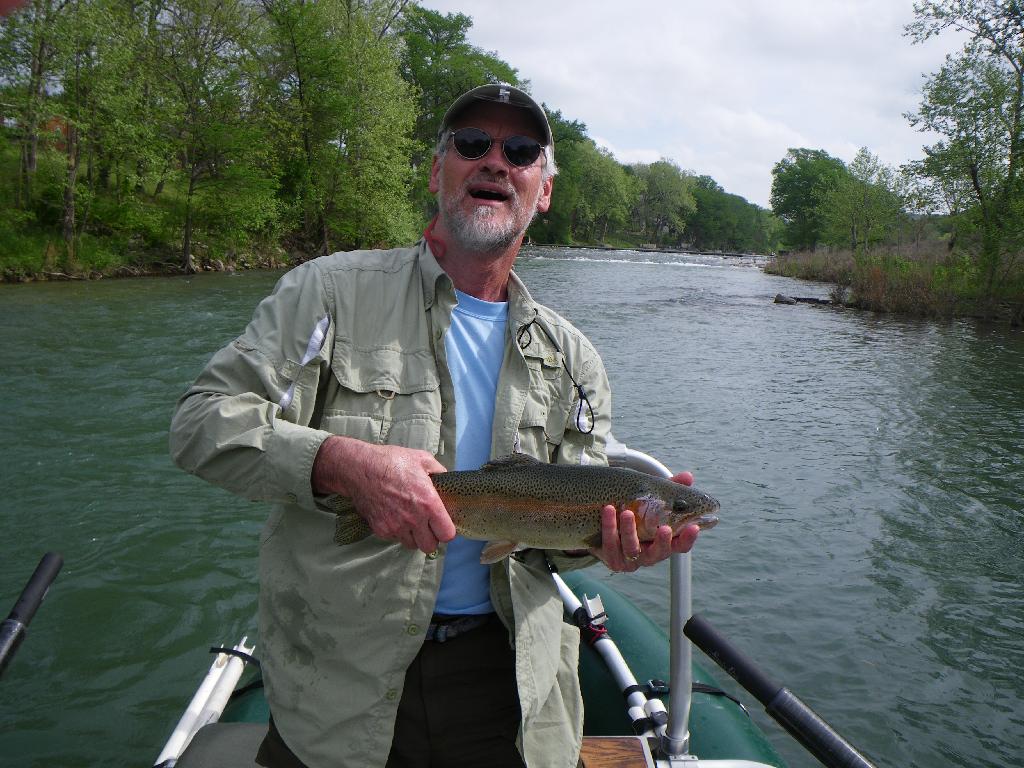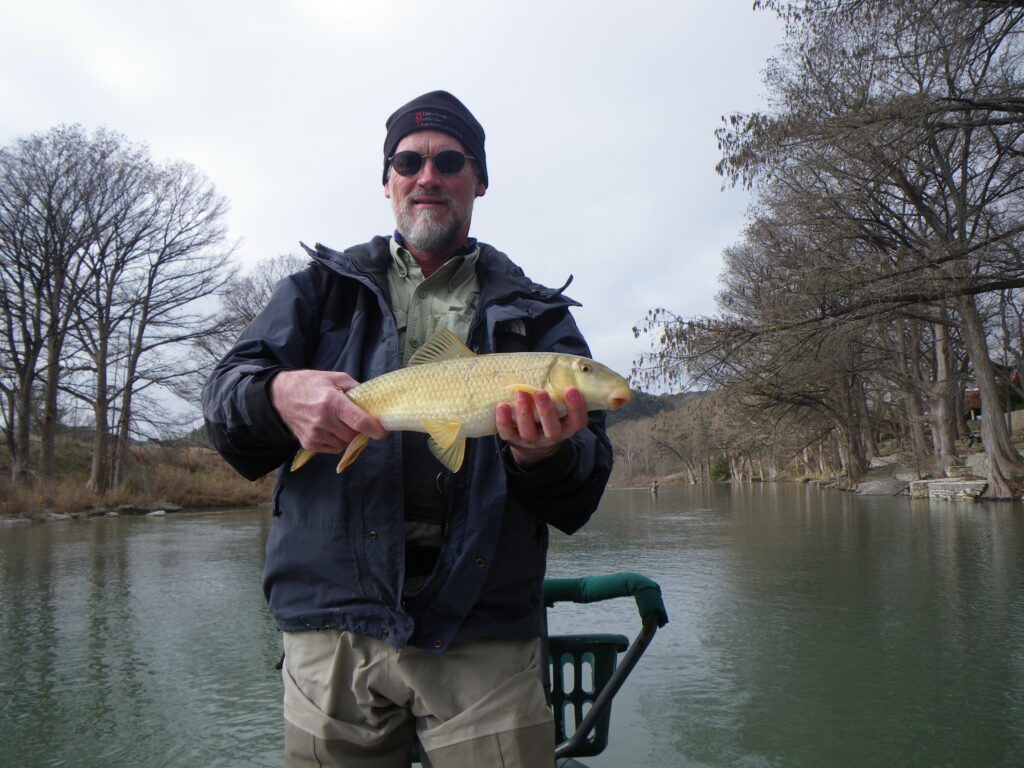
Recreation & Access
The intended audience for this page is kayak and raft fishers. One issue about paddling this part of the Guad is lack of public access due to private resort homes built neck to neck along the river. But there are many outfitters along the way that allow launching boats or taking out. All of them generally require a fee for parking or access. Some are not open during winter season. Do not trespass. Observe traffic signs. Access possibilities exist at Canyon Dam, commercial access at the 306 bridges, 4th Crossing-RioRaft, LazyL&L, 2nd Crossing, Huaco Falls Camp, Gruene Crossing and Cypress Bend. Above 2nd Crossing, the main rapid is Devils Playground. Below 2nd Crossing be aware of Huaco Falls, Slumber, Cypress / Clutter and Gruene rapid (drone video).
Quick Info
| Length | 7 miles (11 miles Canyon Dam to Gruene) |
| Class (I-VI) | I-II |
| Minimum Flow | 100 cfs raft; 75 cfs kayak (float fishing only) |
| Ideal Flow | 100-200 cfs (float fishing only) |
| Maximum Flow | 500 cfs (float fishing only) |
| Current River Conditions | Sattler: USGS Water Data |
| Put-in maps | Guadalupe 4th Crossing, Sattler, others |
| Take-out maps | Guadalupe 2nd Crossing, Rocky Beach, L&L, others |
| Boats | Canoes, Kayaks, Small rafts, SUP |
| Season | Year-round, weather/flow permitting |
| Highlight | GRTU stocks trout in the winter, catch & release. Fun splashy whitewater. |
Fishing
If you are paddling November to April, before tubing season (the rubber hatch), please be courteous to wading fly-fishers. On the Guadalupe Trophy Trout section (below Canyon Dam to 2nd Crossing) from November to April, GRTU members in the Lease Access Program pay landowners for access and parking easements to wade the river and they also stock the river with very large Rainbow and Brown Trout. Anybody with a fishing license may catch these fish. This is in addition to TPWD standard Rainbow stocking program. However, all fishers are encouraged to practice barbless Catch & Release and not use live bait. Artificial lures and flies help increase the survival rate of fish in catch and release fishing by reducing deep hooking – an occurrence that leads to higher mortality rates in fish. Please note: Two sections of this river are subject to special harvest regulations on rainbow and brown trout. In these sections, all trout harvested must be caught on artificial lures, bag and size limits are in effect. Give the trout a break when after March. Target Stripers or LMB instead. Trout-eating Stripers below Canyon Dam in the range of 20-30 lb. are not uncommon.
Canoe / kayak / raft etiquette when encountering a wading angler: Communicate. Normally you should try to float behind the angler. Warn the angler you are behind them to avoid getting hit by a back cast. Sometimes in low water conditions you may have to float in front of the angler. If you find yourself in this position, stop and wait, give them a chance to motion you through. If the angler does not see you, let the angler know you are coming through and make sure they don’t have a fish on. Only paddle when necessary and then don’t splash or smack the paddles on the water. Short soft strokes. Stay as far as possible from the area being fished. Also, act apologetic and wish them good luck. Most anglers are very understanding and they will appreciate your courtesy.
Conservation & Threats
Excess algae due to high nutrient run-off. Invasive Zebra mussels. Always wash your boats well between watersheds. Didymosphenia geminata, commonly referred to as “didymo” or “rock snot,” is an invasive freshwater microscopic non-toxic diatom. It thrives in cold, clear, shallow streams. Invasives such as the Suckermouth Armored Catfish (SAC).
Natural Features
Bald cypress, Taxodium distichum, are among the biggest, tallest and longest-lived trees in Texas. Some have reportedly reached an age of 800 to 1,200 years. When young, they’re shaped liked Christmas trees, but as they age, the crown tends to open up and the branches lift skyward, forming a massive, lofty, overarching canopy. The bald cypress were around with the dinosaurs. Bald eagles and ospreys take full advantage of the height of these trees to nest on the river. Growing naturally in or near water, the Bald cypress lines the Upper Guadalupe River as well as other Hill Country and East Texas rivers. Famous for its knees, which are thought to provide air to the roots or to serve as anchors.
Ashe Juniper, Juniperus ashei, is also called mountain cedar. Ashe juniper provides an evergreen fragrance and nesting material for the Golden cheek warbler. Possibly 60% of the woodlands coverage of the Upper Guadalupe River valley are Ashe Juniper.
Historical and Cultural Significance
Canyon Dam was impounded in 1964. When cold water began to flow from dam releases, Lone Star Brewery was the first to stock trout. The stewards of Guadalupe River Chapter of Trout Unlimited, working with TPWD, had the vision of a trout stocking program that would change the face of fly-fishing in Central Texas. They probably expected it to be no more than a “put and take” fishery, but years have demonstrated that quite a few big old trout can survive summer heat in a few of the deep holes. Today GRTU has the largest membership of any US TU chapter. Although that little fact may have as much to do with Texas fly-fishers traveling North America in piscatorial pursuits, it also tells the story of many dedicated GRTU fly-fishers since the 1960’s whose legacy is a tail race fishery that provides great economic impact locally and is known around the country for incredible trout angling. Here’s the full history from GRTU.
Additional Resources
- Guadalupe River Chapter of Trout Unlimited
- Allwater Guides Fly Fishing
- Castell Guide Service
- Expedition Outfitters
- Hill Country FlyFishers
- Fly-Fishing the Texas Hill Country, by Kevin Hutchison
- TPWD Guadalupe River Trout Fishing Regulations

